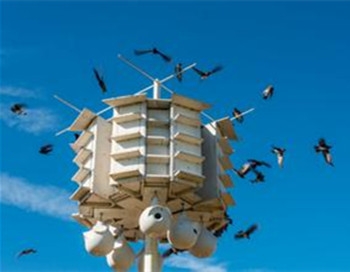
Where purple martins had once laid their eggs in hollow threes, in time, they came to rely almost totally on people to provide nests for them.
北美洲紫燕曾在这些中空的大树中下蛋,而现在,他们基本上完全依赖于人们为他们建造的巢穴。
These artificial nests were made from dried out squashes known as gourds. The shape made them perfect nesting sites for these birds. But what triggered this special relationship in the first place? It’s possible the insect-eating martins helped to control pests living around Native American camps. Whatever the original reason, the traditional tie between people and purple martins survives to this day. But now, in keeping with the modern world, hollow gourds have often been replaced by high-rise apartment blocks.
这些人造巢穴是由风干的葫芦制造的。葫芦的形状使葫芦成为这些鸟儿下蛋的最佳场所。但是,人类和北美洲紫燕最初是怎样建立起这样一种特殊的关系呢?答案可能是这些紫燕捕食昆虫,帮助了美洲土著居民控制营地周围的昆虫数量。不管最初的原因是什么,人类与紫燕这样的一种传统关系一直持续至今。但是如今,为了与时俱进,中空的葫芦被一些耸立的,并具有现代建筑风格的鸟巢所取代。
This special relationship between purple martins and people is one of the few in North America to cross cultural boundaries between native groups and European settlers. Other animals to cross this cultural divide did so for different reasons.
人类与紫燕这样的一种特殊关系仅是北美本土种族和欧洲外来者的文化交融关系之一。而其他跨越文化差异的动物选择这么去做也是有不同原因的。
More than 50 million wild turkeys were living in North America when the first Europeans arrived. They were occasionally hunted by the native people, but the European settlers had a taste for turkey and they took this to extremes. As hunting intensified, wild turkey populations plummeted.
在第一批欧洲人来到北美时,北美有五千多万只野生火鸡。它们时常被当地人捕食,但是欧洲人对火鸡情有独钟,因此他们吃火鸡极为频繁,随着捕杀的加剧,野生火鸡数量急剧下降。
The turkey became a central part of Thanksgiving Day celebrations and was almost hunted to extinction.
火鸡也是感恩节庆祝的核心菜肴,当时由于被捕杀,几乎灭绝。
英文文本来自普特英语,译文属可可原创,仅供学习交流使用,未经许可不得转载。












